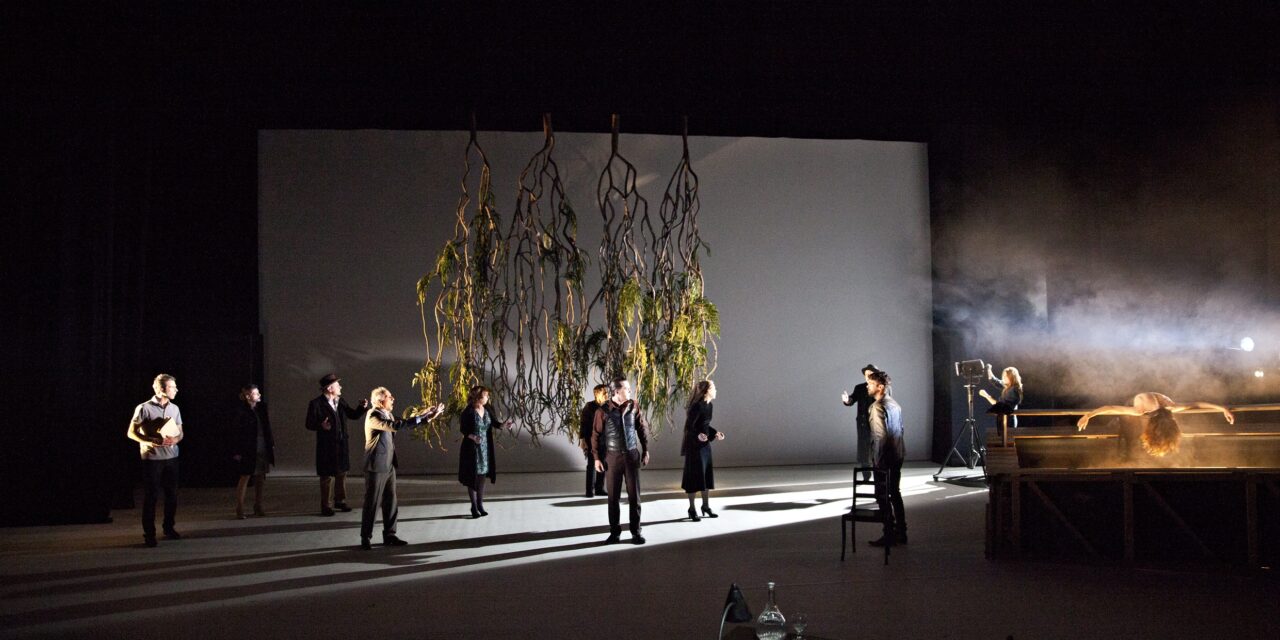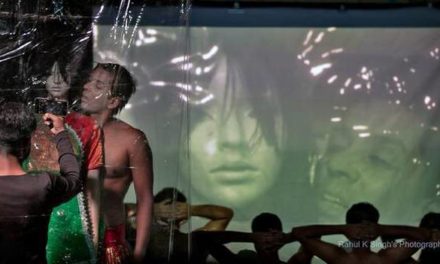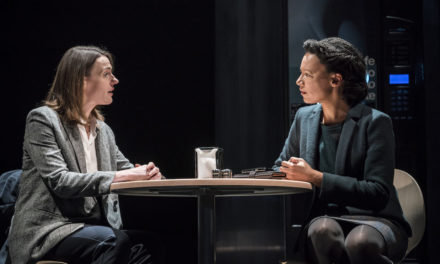To re-open its season after the lifting of COVID-19-related restrictions, Paris’s Théâtre de la Ville consortium is welcoming back one of its former productions: Six Characters in Search of an Author (Six personnages en quête d’un auteur), directed by current artistic director Emmanuel Demarcy-Mota.[i] Staged between May 19, 2021, and June 13, 2021, the event is a homecoming for this mise-en-scène, which debuted at the Théâtre de la Ville twenty years ago (in October 2001) and has since been on tour in France and internationally (in London, New York, and Berlin among other places). The event also marks a century since Six Characters, written by Italian playwright Luigi Pirandello (1867-1936), first shocked spectators with this play about a play, in which incomplete characters of a playwright’s imagination wander aimlessly in search of an author to let them live out their lives as a full theatrical creation. Demarcy-Mota’s production is a well-oiled machine with the trio Alain Libolt, Hugues Quester, and Valérie Dashwood having played the Manager, the Father, and the Step-Daughter since its début in 2001. As spectators were reminded at the start of the current production, Pirandello wrote this play in a period of crisis after the First World War. The play’s emphasis on dialogue and collaboration in the theatre-making process remains timely today, as theatre faces a new period of crisis and renaissance in the post-pandemic world.
Six characters appear at the door of a theatre while rehearsal for the play Mixing It Up (by none other than Pirandello himself) is in full swing. They present themselves as exiles from the imagination of an author who had abandoned them mid-route. A “legitimate” son bears an unexplained grudge on his mother; a Boy commits suicide, his outsider status never fully elucidated but masterfully captured by the hunched gestures and contorted grimaces of Chloé Chazé; a mainstay of theatrical tragedy, the act of incest, is alluded to and simultaneously denied. In a gender reversal of Oedipus, a Father and Step-Daughter may have had relations or they may have been stopped by the inexplicably pitiful mother. The stories lack enough detail to hold together individually and as an ensemble. The six characters beseech the theatre Manager (played by Alain Libolt) to give them a coherent story. He immediately stops work on Mixing It Up, a second-rate play anyway, and enlists the six actors he currently has on-site for rehearsal of the new drama.
Pirandello’s Six Characters prompted a riot when first staged at the Teatro Valle in Rome in 1921. Spectators had never seen a mise-en-abyme of theatre quite like it before. Six Characters was a protest against the crisis-state of the Italian theatre industry in the wake of World War I, which found itself without state funding. A rapid turnover of productions was meant to secure profit, but led to actors becoming the puppets of hasty rehearsals and badly-written texts.[ii] Associated with Art theatre movement in Europe, Six Characters is also of cultural significance in the French theatrical repertoire. According to the records at France’s National Library, the play has been produced twenty-four times in France over the last century.[iii] George Pitoëff’s version at the Comédie des Champs-Elysée in 1923 became a signature production to which Pirandello himself referred.[iv] The play has had an enduring legacy on the French avant-garde, as Demarcy-Mota’s production illustrates. Vanguardist Antonin Artaud’s reaction to Pitoëff’s production of Six Characters is re-printed in the program and on the theatre curtain before the dramatic action begins. Pirandellian meta-theatre, circularity, and incompleteness found echoes in the depthless characters, of Samuel Beckett, Eugène Ionesco, Jean Genet, among others.
Pirandello wrote this play as a plea for adequate rehearsal time in which a careful dialogue was established between actors, playwrights, and directors.[v] As if to drive home the point that theatre is much more than a (badly written) text, Act I is almost entirely a feat of endurance for spectators in Demarcy-Mota’s production. The unfinished characters (Father, Step-Daughter, Mother, Son, the Boy, the Child) indulge in untheatrical speeches on how they came to be, the density of their half-stories making the piece hard to follow. Demarcy-Mota’s production then creates fluid visual poetry in the next two acts. At the very end of Act I, the characters leave the stage in an elevator (as a possible nod to Pitoëff’s 1923 production).[vi] The wooden shaft of the elevator provides a frame on this Frankenstein-like family hoping to be brought to life by the theatre Manager.
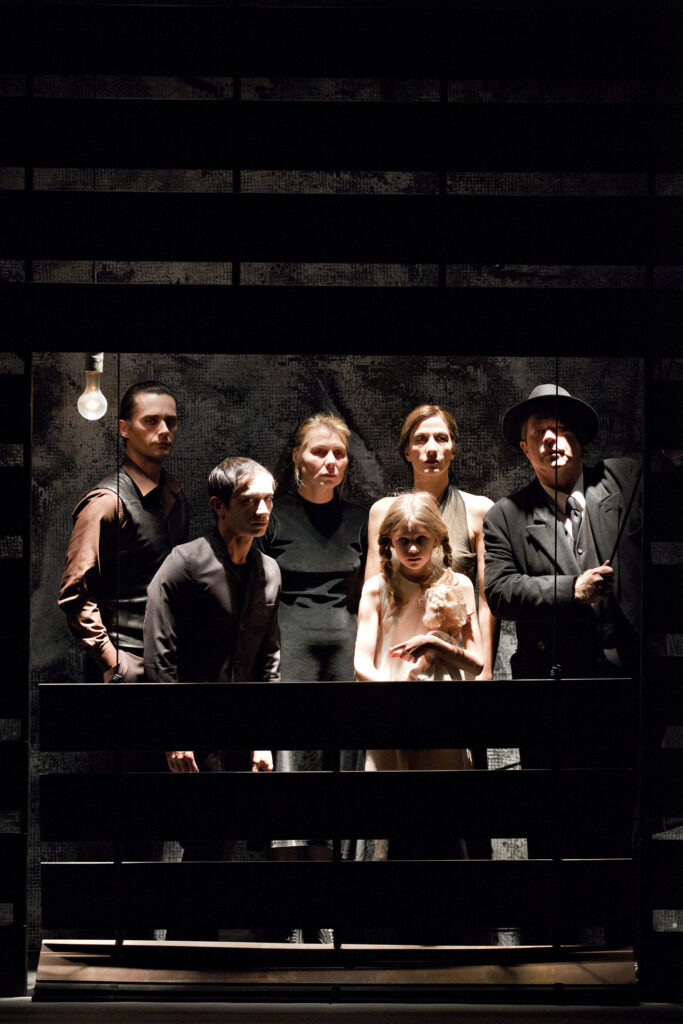
The exit in the wooden elevator framing this Frankenstein-like family. PC: Jean-Louis Fernandez.
Later scenes also stress the power of the visual: heavy black overcoats descend from the rafters to symbolize male domination in the brothel where the Step-Daughter (Valérie Dashwood) prepares to commit the act of incest with the Father; green foliage (enlisted at the behest of the theatre Manager) captures the garden where the Child drowns in a pond, breaking her sister’s (the Step-Daughter’s) heart; magnified projections of the Father and Mother behind a silhouetted screen imply the Step-Daughter’s helplessness and victimization in the crossfire between the parents.
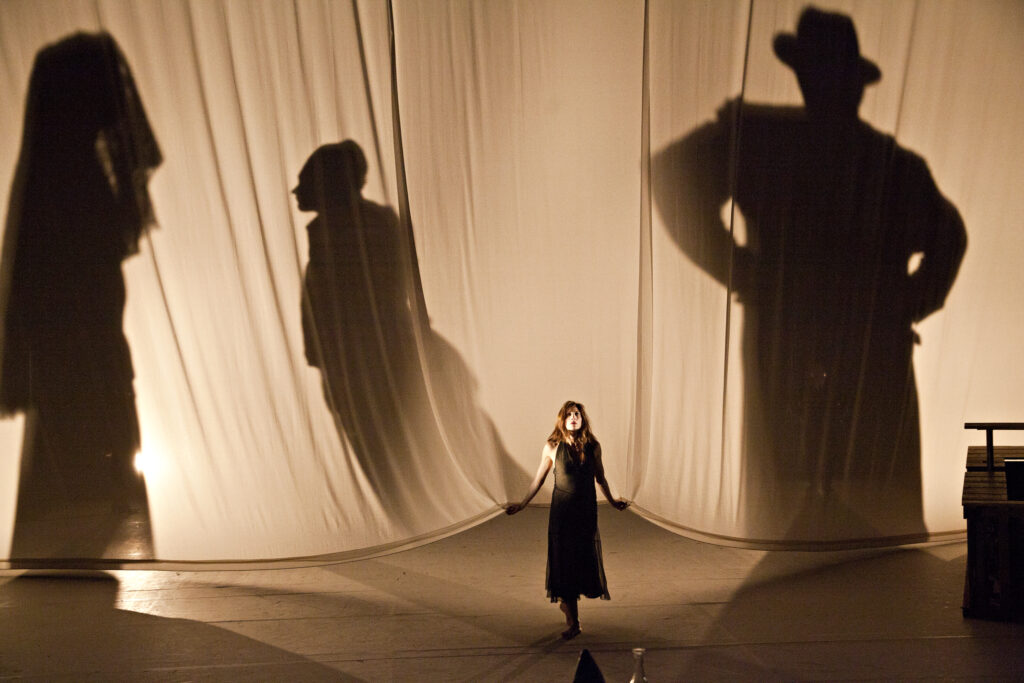
The silhouetted figures of the parents behind the Step-Daughter. PC: Jean-Louis Fernandez.
Pirandello’s play and the visual poetry of Demarcy-Mota’s production provide a reminder that theatre needs a whole team of people—scenographers, lighting engineers, makeup and costume artists—to work. This gains political resonance in the current French climate where contractual theatre-makers and technicians are seeing their rights drastically reduced by Emmanuel Macron’s reforms to social aid and unemployment benefit, creating a two-tier system between the big “stars” of theatre (artistic directors of mainstream theatres, famous actors and actresses) and the rest of the theatre-making industry.[vii] From a stage carpenter’s hammering a wooden floor to the ground in the very first moments to the actors who do not listen to the characters’ directives, Six Characters lays bare the vital importance of collaboration in theatre-making.
Connections to the current moment also open up new questions about the renewal of this production in a post-COVID-19 world. Pirandello’s play demonstrates the power imbalances that can destroy theatre at its roots. The theatre Manager (directeur)—who is emphatically not a director (metteur-en-scène)—is a tyrannical character more interested in profit than really understanding these half-conceived characters. His troupe of actors are the fruit of his incompetence. They are clueless individuals who cannot get the characterizations of the six right, demonstrating by parody the influence of the Stanislavski system on Pirandello’s work.[viii]
A century after Pirandello, the movements related to “We See You White American Theatre” and “We Need to Talk About Dramaturgy” in the US and the UK, and France’s own collective Décoloniser Les Arts (Decolonize the Arts) have all denounced similar structural injustices in the theatre-making process, pinpointing white domination as the main cause. The current moment is of course separate and distinct from the forces driving Pirandello’s reflections, and his relationship to Fascism remains a blockage for many contemporary theatre-makers.[ix] However, the premise of Six Characters is potentially ripe for re-appropriation today. The playwright envisioned autonomy for his six unfinished characters. As he stated in the preface to the play, “[t]hey are detached from me; live on their own; have acquired voice and movement”.[x] This potentially chimes with the decolonizing theatre movement today defined by calls to eliminate white management in theatre, to give artistic freedom to racialized actors playing characters, and to make rehearsal spaces more democratic places.
Six Characters has historically been an all-white affair in the French context, and Demarcy-Mota’s production is no exception. More broadly, the Théâtre de la Ville’s program, under Demarcy-Mota’s direction, typifies a double-practice in the French context described by a founding member of Décoloniser Les Arts, Eva Doumbia. As Doumbia points out, mainstream French theatres have preferred to avoid the issue of racial injustice experienced by France’s own racialized populations by inviting directors and creators from Francophone Africa to create their plays on French soil;[xi] or by commissioning plays by “white directors [made] […] for white audiences”.[xii] Among other strategies, the French theatre industry should look to de-whiten culturally important classics in its repertoire like Pirandello’s Six Characters, which potentially lend themselves to current debates on the democratization of the theatre process.
Footnotes
[i] https://www.theatredelaville-paris.com/en/spectacles/saison-2020-2021/theatre/six-personnages-en-quete-dauteur (accessed 1 June 2021).
[ii] Susan Bassnett and Jennifer Lorch, Luigi Pirandello in the Theatre (London: Routledge, 1993), 9.
[iii] https://data.bnf.fr/en/search?term=six+personnages (accessed 1 June 2021).
[iv] Bassnett and Lorch, 54.
[v] Bassnett and Lorch, 54.
[vi] Pitoëff introduced the concept of the six characters arriving via an elevator, which reportedly displeased Pirandello at first but the Italian playwright eventually came to appreciate the technique. Bassnett and Lorch, 12.
[vii] A large number of theatre-makers in France work under the status of “intermittent de spectacle”, which requires them to work a certain number of hours per annum in exchange for which they will have a social security allowance. The reforms that Emmanuel Macron is introducing to unemployment benefit risks unfairly penalizing those intermittents de spectacle who have not managed to complete their requisite hours because of the closure of cultural centres during the pandemic. Movements led by theatre-makers such as #OccupationOdéon are protesting Macron’s reforms.
[viii] Bassnett and Lorch, 9.
[ix] Bassnett and Lorch, 13.
[x] Luigi Pirandello, “Preface to Six Characters in Search of an Author (1925)”. Pirandello Web. https://www.pirandelloweb.com/six-characters-in-search-of-an-author-preface/ (accessed 1 June 2021).
[xi] For instance, later in June 2021, Malian director Alioune Ifra N’Diaye will stage Inch’Allah later in June 2021 at the Théâtre de la Ville. https://www.theatredelaville-paris.com/en/spectacles/saison-2020-2021/africa2020/inchallah (accessed 1 June 2021).
[xii] Eva Doumbia quoted in Alex Marshall, “‘I Have to Go in and Decolonize’: Europe’s Black Theater Makers Discuss the Scene”. NY Times. 20 July 2020. https://www.nytimes.com/2020/07/20/theater/theater-diversity-europe.html (accessed 1 June 2021). Demarcy-Mota’s production of Sorcières de Salem in March 2020 demonstrates the white directorship for white audiences of plays about race, suggested by Doumbia. https://www.theatredelaville-paris.com/en/spectacles/saison-2020-2021/theatre/les-sorcieres-de-salem-2 (accessed 1 June 2021).
This post was written by the author in their personal capacity.The opinions expressed in this article are the author’s own and do not reflect the view of The Theatre Times, their staff or collaborators.
This post was written by Lara Cox.
The views expressed here belong to the author and do not necessarily reflect our views and opinions.

